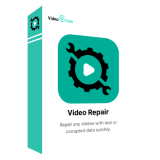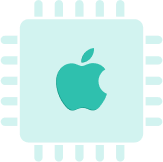Have you ever sat down to view a video and discovered that it was blurry, grainy, or blocky? That's irritating, isn't it? Pixelation may totally destroy the viewing experience, whether you're watching your favourite movie, editing a video project, or playing back an important recording.
Thankfully, you can fix pixels on videos to restore the clarity and smoothness using the correct tools and methods. This article will discuss the most common reasons why movies have pixelation, provide workable fixes (such the powerful AI restoration tool VideoSolo Video repair), and offer tips on how to prevent pixelation in the future.
Reasons Causing Videos to Become Pixelated
Pixelation is not a random thing. It generally indicates that an error occurred during one of the following: recording, compression, playback, or storage. For your reference, let’s take a closer look at the reasons to help you better identify the cause and tell you how to fix pixelated videos.
• Low-quality video: If the original video was captured at a low resolution such as 240p or 360p, it will always appear pixelated when blown up to fit your screen.
• Over-compression: If your video has been highly compressed during exporting or storage, it may occasionally lose quality and cause block-like images.
• Damage to the file Pixel blocks may appear in place of discrete images in video files that are partially downloaded or corrupted.
• Inadequate network streaming: The platform may automatically reduce resolution while streaming online with a poor internet connection, which might lead to pixelation.
• Codecs Issue: Codecs that are outdated or incompatible Your media player may exhibit pixelation or playing issues if it does not correctly handle the video format.
Selecting the best treatment is made simpler when the reason is known.
How to Fix Pixels on Videos
Now let’s get practical. These are tried-and-true methods for pixelated video restoration that will make them seem crisp again. Your questions on how to fix pixelated videos on iphone and how to fix pixelated videos on Android can be easily solved.
Method 1: Use VideoSolo Video Repair (Best Choice)
Manual adjustments won't make much of a difference if your video is pixelated because to corruption, bugs, or file damage. This is where the AI-powered repair application VideoSolo Video Repair is useful.
VideoSolo Video Repair allows you to fix pixelated videos in clicks. No matter your video suffers from audio damage, pixelation, choppiness, or playback errors, this tool could recover your video to a clear and smooth state. Mac and Windows are supported , and it works with popular file formats, including MP4, MOV, AVI, MKV, and more.

- AI-powered repair: Automatically analyzes corrupted videos and restores them without quality loss.
- Supports multiple formats: Works with almost all popular video file types.
- Preview function: Check the repaired video before saving.
- Simple interface: No technical skills required; beginners can use it easily.
Steps
Step 1. Step 1: Click the section on the left and upload your damaged video.
Step 2. Step 2: Upload a sample video to help the app fix your video. The target video will keep its resolution and framerate the same as the sample video.
Step 3. Step 3: Click Repair to start repairing. It can automatically enact restoration to bring the smoothest result.
Within minutes, this best metadata video editor have fixed the pixelated video, and you’ll often find that your silent video now plays perfectly with both sound and picture restored.
Method 2: Fix Pixelated Video with Adobe After Effects
Adobe offers a suite of professional and sophisticated platform to help users improve the video quality, resize videos, and enhance the visual style of movies, including After Effects. Among them, Adobe After Effects is regarded as one of the most popular visual effects tools. Its built-in "Remove Grain" feature can help you easily remove grain and pixelation in your videos. The effect can be applied to the entire image or a specific section and can eliminate excessive grain caused by insufficient lighting or high ISO during shooting. The following comprehensive guide shows how to unpixelate videos with Adobe After Effects.
Stpes
Step 1. Step 1: Get After Effects from Adobe's official website and install it.
Step 2. Step 2: Drag the pixelated video to the timeline after importing it.
Step 3. Step 3: From the Effects & Preset menu, drag the "Remove Grain" effect to the composition area. Then, view the preview outcome.
Step 4. Step 4: To make the movie more realistic, choose the "Noise Reduction" settings and modify the Noise Reduction parameters.
Step 5. Step 5: To apply the effect throughout the entire region, switch "Preview" to "Final Output" and export the video with the pixelation eliminated.
Method 3: Check Media Player & Codec Settings
Sometimes pixelation is caused by the player, not the video file itself. Here is what you can do to fix pixelated videos:
Step 1. Updating your media player (e.g., VLC, Windows Media Player).
Step 2. Installing the latest codecs.
Step 3. Testing the video in a different player to see if the issue persists.
Method 4: Adjust Playback Settings in VLC
VLC Media Player is free and offers several fixes to pixelated videos:
Step 1. Go to Tools > Preferences > Video and check if hardware-accelerated decoding is enabled.
Step 2. Increase the caching value under Input/Codecs to smooth playback.
Step 3. Change the output module (e.g., from Direct3D to OpenGL) if you suspect GPU rendering issues.
These don’t “fix” the video file itself, but they can improve playback quality for slightly damaged or compressed videos.
Method 5: Convert Video to a Different Format
Sometimes pixelated video is due to a codec incompatibility between your device and the video. In this case, converting to a more compatible format (MP4 with H.264 or H.265 encoder is the most compatible one) may fix the pixelation. You could use any free converter to help you with video conversion. But if your video is already corrupted, a video repair tool is more advisable.
How to Prevent Videos from Getting Pixeled
Once you’ve fixed pixelated videos, you don’t want the problem to come back. Here are some tips for prevention:
• Always record at the highest resolution supported by your camera, ideally 1080p or 4K.
• Avoid over-compressing: When exporting videos, try to strike a balance between file size and quality.
• Use secure storage: Always store your videos on reputable storage devices or cloud services to minimize the chance of corruption.
• Maintain stable internet – For streaming or video calls, ensure a strong connection to prevent automatic resolution drops.
• Back up your files – Keep a backup of important videos in case the original gets damaged.
FAQs about Fixing Pixels on Videos
Can pixelated videos be fixed completely?
Yes, programs like VideoSolo Video Repair may completely repair them if the pixelation is caused by corruption or problems with playing. If poor resolution is the cause, you can enhance clarity without precisely recreating details.
Is it possible to restore pixelated films for free?
When compared to professional repair software like VideoSolo Video Repair, the results of using free programs like VLC or internet editors are frequently less impressive.
Does every kind of video corruption get fixed by VideoSolo Video Repair?
Pixelation, blurriness, playback faults, and header corruption are just a few of the major problems it fixes. Although the results may differ, it usually helps.
Conclusion
Videos with pixelation can be bothersome, but they don't have to be. Understanding the common causes, such as corrupted files, poor quality, and compression, can help you choose the best course of action to fix pixels on videos. VideoSolo Video Repair is the most dependable solution for severe situations. It saves you frustration by swiftly and effectively repairing broken or pixelated files using AI. By combining this with sound recording methods and file management, you can preserve the sharpness and clarity of your films over time. You will have the skills and knowledge needed to promptly fix any pixelated movies you see in the future.
More Reading

Repair your damaged, unplayable videos with multiple mainstream formats like MP4, MOV, 3GP, etc.




 wpDiscuz
wpDiscuz